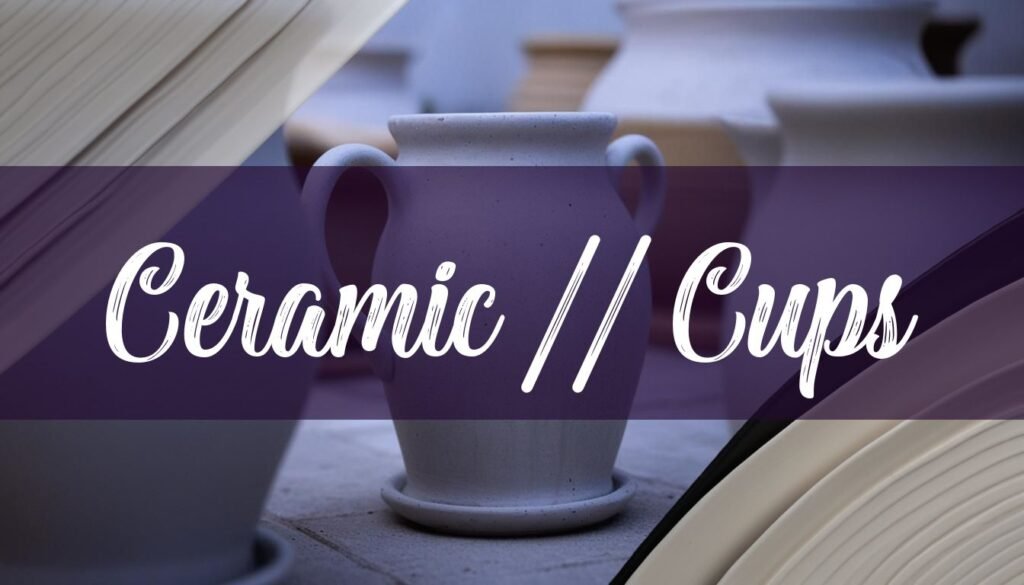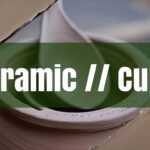Crafting ceramic cups is a rewarding journey that blends artistry with functionality. Whether you’re a beginner eager to get your hands dirty or an intermediate ceramicist looking to refine your skills, understanding the process is key. This guide will walk you through the essential tools, materials, and techniques needed to create your own unique ceramic cups.
Gathering Supplies: Choosing the Right Clay
First, let’s gather our supplies. The type of clay you choose will significantly impact the final product. Earthenware is a popular low-fire option, known for its plasticity and minimal warping, with terracotta being a well-loved variety. Earthenware, containing iron and other minerals, reaches optimal hardness between 1745℉ (950℃) and 2012℉ (1100℃) (Read more about kiln temperature ranges for pottery). Stoneware, a mid-range clay, is versatile and often grey when moist, requiring firing temperatures between 2124℉ and 2264℉ (1162-1240℃) (Again, learn more about kiln temperature ranges for pottery). Porcelain, known for its whiteness and translucency, demands the highest firing temperatures, typically between 2381℉ and 2455℉ (1305℃ and 1346℃) (See also, kiln temperature ranges for pottery). Keep in mind that choosing the right clay also means understanding its firing range to prevent issues like slumping or bloating in the kiln (Check out this guide on avoiding issues in the kiln). You might also find it useful to read our guide answering the question: What type of clay is used for ceramics? A potter’s guide.
Beyond clay, you’ll need essential tools such as a pottery wheel (if you plan to throw your cups), trimming tools for refining shapes, and various hand-building tools for sculpting and detailing (See this page with pottery tools for sale). Aprons, sponges, brushes, calipers, and wire cutters are also invaluable for keeping your workspace clean, shaping the clay, applying glazes, measuring dimensions, and cutting clay efficiently (Read about the best pottery tools). And, of course, you’ll need a kiln to fire your creations. More information about kilns can be found in our article: Kiln care 101: Maintenance tips for potters.
Shaping Techniques
There are primarily three methods for shaping ceramic cups: wheel throwing, hand-building, and slip casting. Wheel throwing involves shaping clay on a rotating pottery wheel, using centrifugal force to create symmetrical forms (Learn more about wheel throwing techniques). This technique allows for precision and thinner vessels, but requires practice and skill to master.
Hand-building, on the other hand, relies solely on your hands to form the clay (More on hand building techniques here). The three main hand-building techniques are pinching, coiling, and slab building. Pinching involves starting with a ball of clay and shaping it with your fingers (See more about hand building). Coiling uses long rolls of clay stacked and joined together (Ditto, hand building techniques here). Slab building involves joining flat pieces of clay to create the desired form (And again, hand building techniques here). Hand-building offers more freedom in creating unique, asymmetrical shapes, making it ideal for sculptural designs.
Slip casting involves pouring liquid clay (slip) into a mold (More about pottery making methods). Once a layer of clay has formed against the mold walls, the excess slip is poured out, leaving a hollow shape. Slip casting is excellent for producing identical cups with thinner walls and smooth surfaces (Read about pottery making methods).
Drying, Firing, and Glazing
Once your cup is shaped, it needs to dry slowly and evenly to prevent cracking. This can take several days, depending on the humidity and thickness of the clay. Once the cup is bone dry, it’s ready for bisque firing. This initial firing hardens the clay, making it easier to handle for glazing.
Glazing is the process of applying a decorative and protective coating to the bisque-fired cup. Glazes are made up of glass-formers, fluxes, and stabilizers, and come in various finishes, such as glossy, matte, and satin matte (Explore the world of how to glaze pottery here). Common glazing techniques include dipping, brushing, and spraying (More glazing info here). Dipping involves submerging the cup in glaze for an even coating (More glaze info here). Brushing allows for more controlled application, while spraying provides a smooth, uniform finish (More glaze info here). After glazing, the cup undergoes a final glaze firing, which melts the glaze and bonds it to the clay body (More glaze info here).
The durability of a glaze depends on its chemistry and firing temperature (Check out this guide to glaze durability). Glazes with high amounts of alumina and silica are generally more durable. It’s crucial to use food-safe glazes on the interior of cups to prevent leaching of harmful materials (Read about testing glaze durability).
Troubleshooting and Customization
Common problems in ceramic cup making include cracking, warping, and glaze defects. Cracking can occur during drying or firing due to uneven drying or thermal shock (Read about troubleshooting ceramic issues). Warping can result from uneven support during firing or using clay that is too soft. Glaze defects, such as crazing (cracking in the glaze), can be caused by a mismatch between the clay and glaze (Read about cracked ceramic cups).
To prevent these issues, dry your pieces slowly and evenly, use appropriate clay bodies and glazes, and ensure proper firing temperatures. If crazing occurs, be aware that while some consider it merely an aesthetic issue, crazed dishware is often prohibited in commercial settings due to potential bacteria accumulation in the cracks (Read about cracked ceramic cups).
Finally, don’t be afraid to experiment with decorative techniques and customization options. You can add textures, carve designs, or use underglazes to create unique patterns and colors. The possibilities are endless, and the only limit is your imagination. So, embrace the process, learn from your mistakes, and enjoy the journey of creating your own ceramic cups. If you are feeling extra creative, you may want to read about unlocking the magic and mastering crystalline glazes.





